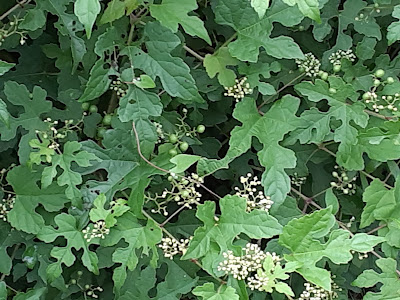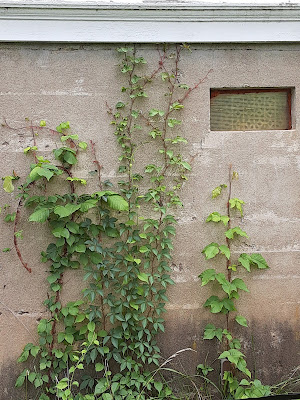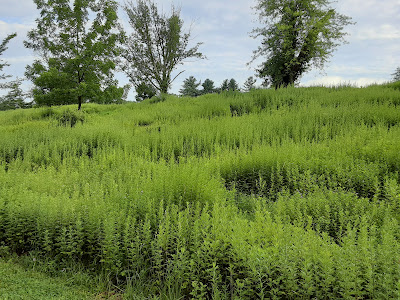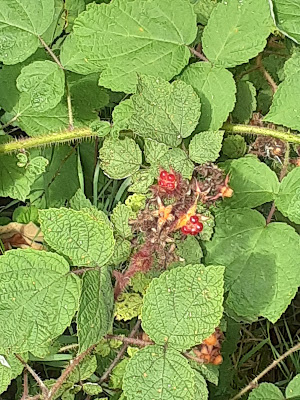It is autumn once again. The ornamental grasses and other shrubbery are turning gold and brown and the trees in my yard have lost their leaves except for the red and white oaks. Other trees in the area have leaves but they are fluttering with each breeze to the ground like rain. Even though age has forced my husband and me to hire a lawn service to get the bulk of the leaves and locust tree pods to the curb, today I went out with my rake because I miss the calm I get from simple yard work outside.
 |
| Male redbelly at his preferred feeder. (Margo D. Beller) |
But though my rake is far more quiet than a leaf blower, the calm was soon broken by the incessant and increasingly high-pitched barking of a neighbor's dog. After I finished, that noise was replaced by several homeowners using the inevitable leaf blower. Here in the suburbs, leaf blower season will last until it finally snows and people will stop caring about having a perfect green lawn.
It is dark at 5 p.m. Eastern Standard Time now, and southbound bird migration is just about done in my area. If the Merlin app on my phone is any guide, there are still a lot of different birds that will be stay through the winter in the general vicinity of my backyard early in the morning. (I usually hear about half of them.) But the catbird, warblers and other summer birds are now far south of here.
Once in a long while I do find something interesting in the yard - a Carolina wren, a gold-crowned kinglet, more recently a yellow-bellied sapsucker softly tapping on a branch of my old apple tree in the dim light of dawn. I like sapsuckers, and rarely see them, but this tree has had enough stress in its life and its trunk is already covered in tiny sapsucker holes of past years. So I walked toward the tree and the bird flew off.
 |
| Nearby tree. The leaves will soon be gone. (Margo D. Beller) |
Now, on my enclosed porch and running a fan to cut the leaf blower noise, I watch my feeders. It is not the coldest of days so there has been little activity. Suddenly, a red-bellied woodpecker - the red going up the back of its neck to its head showing this is a male bird - comes to the house feeder for a sunflower seed. It takes it, flies to a nearby tree and then pounds the seed against a limb to break open the shell and get to the meat.
The redbelly, a medium-sized bird, has drawn the attention of the much smaller downy woodpecker. There is no red spot on the back of the neck, so this is a female. She is on the dogwood tree, closer to the other feeder pole. When the redbelly flies off, she flies to the pole and slides down until she can jump up to the suet that hangs upside down in its feeder.
She picks at the suet, then quickly flies back to the dogwood as the redbelly returns to the house feeder for another seed. This is the law of nature. If you are a little bird and a larger bird, especially one of your type, flies at you, you quickly get out of the way. So each time the redbelly came to the house feeder - first one side, then the other - the downy would leave the suet for the safety of the dogwood.
 |
| Downy woodpecker at suet, back when I hung it near the house feeder. (Margo D. Beller) |
I don't know why this redbelly is not inclined to hang below the suet feeder as downys and the larger hairy woodpeckers do. This bird kept at the house feeder before deciding to try the caged seed feeder that hangs near the suet. The cage feeder is for the little birds but bigger birds like the redbelly will cling to the cage, put its head in and try to grab a seed from the central tube. It is not a comfortable position for the bird and eventually it goes to the house feeder.
The downy, meanwhile, climbed to the top of the dogwood. I thought she would fly off but instead she flew to the pear tree. I turned in my chair and saw her tapping at the trunk. She waited to see if the big bird would come back, then flew to the house feeder for her own seed. She took it back to where she had been on the pear tree to hammer off the shell and get at the seed. The redbelly, perhaps sated, flew off from another tree. The downy ate and later left.
I have seen downys come to the house feeder when titmice and chickadees make their runs back and forth to grab a seed. But should a large jay, redbelly or cardinal fly in, the smaller birds fly to the bushes and wait for the big birds to leave.
This tableau has and will be repeated countless times, especially when the weather becomes colder. At this time of year I am not nearly as active as I would like. I feel aches and pains more often. I dread the coming of cold, snow and the dry heat from the furnace that affects my sinuses.
When life becomes still, watching the feeders will be the best thing I do.




































